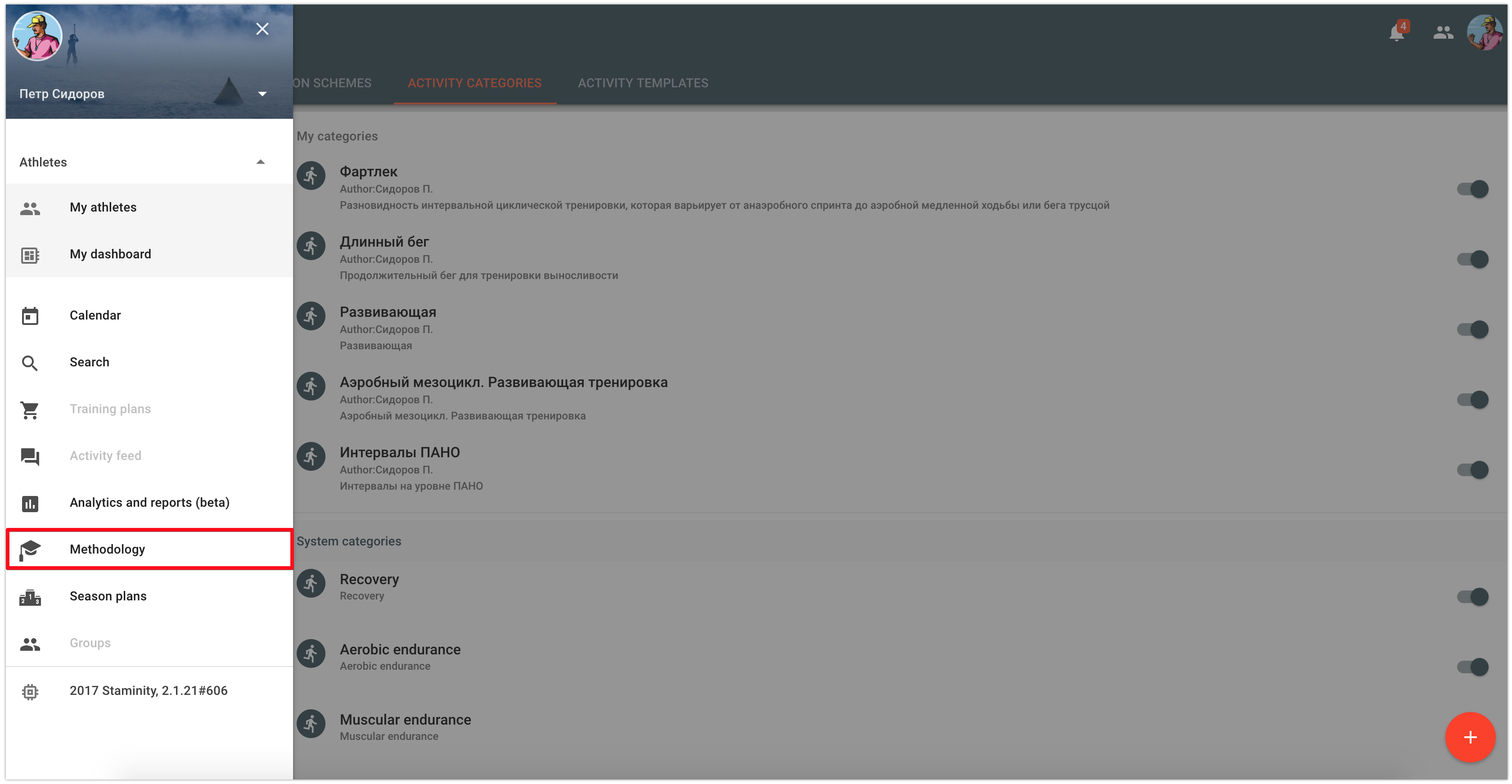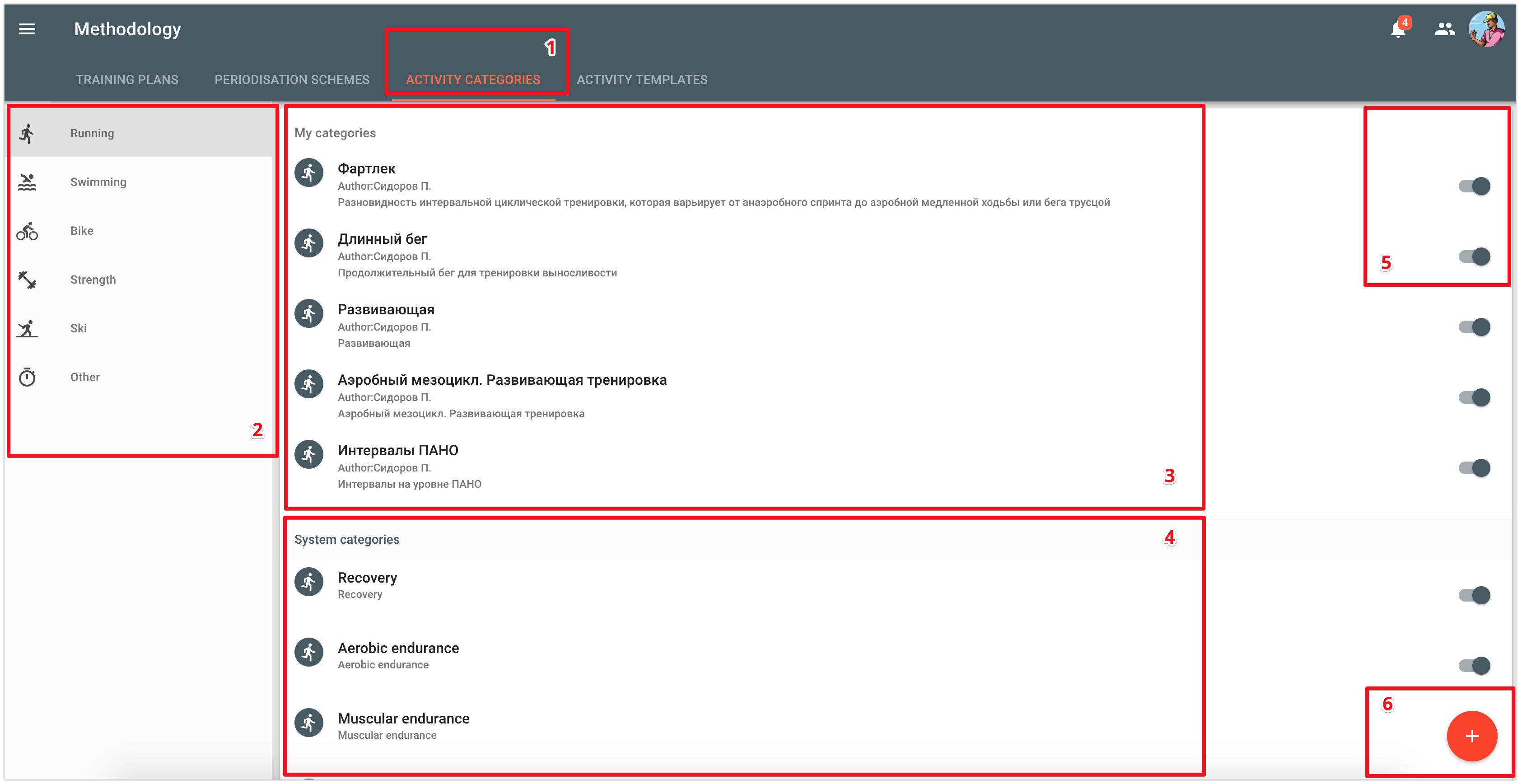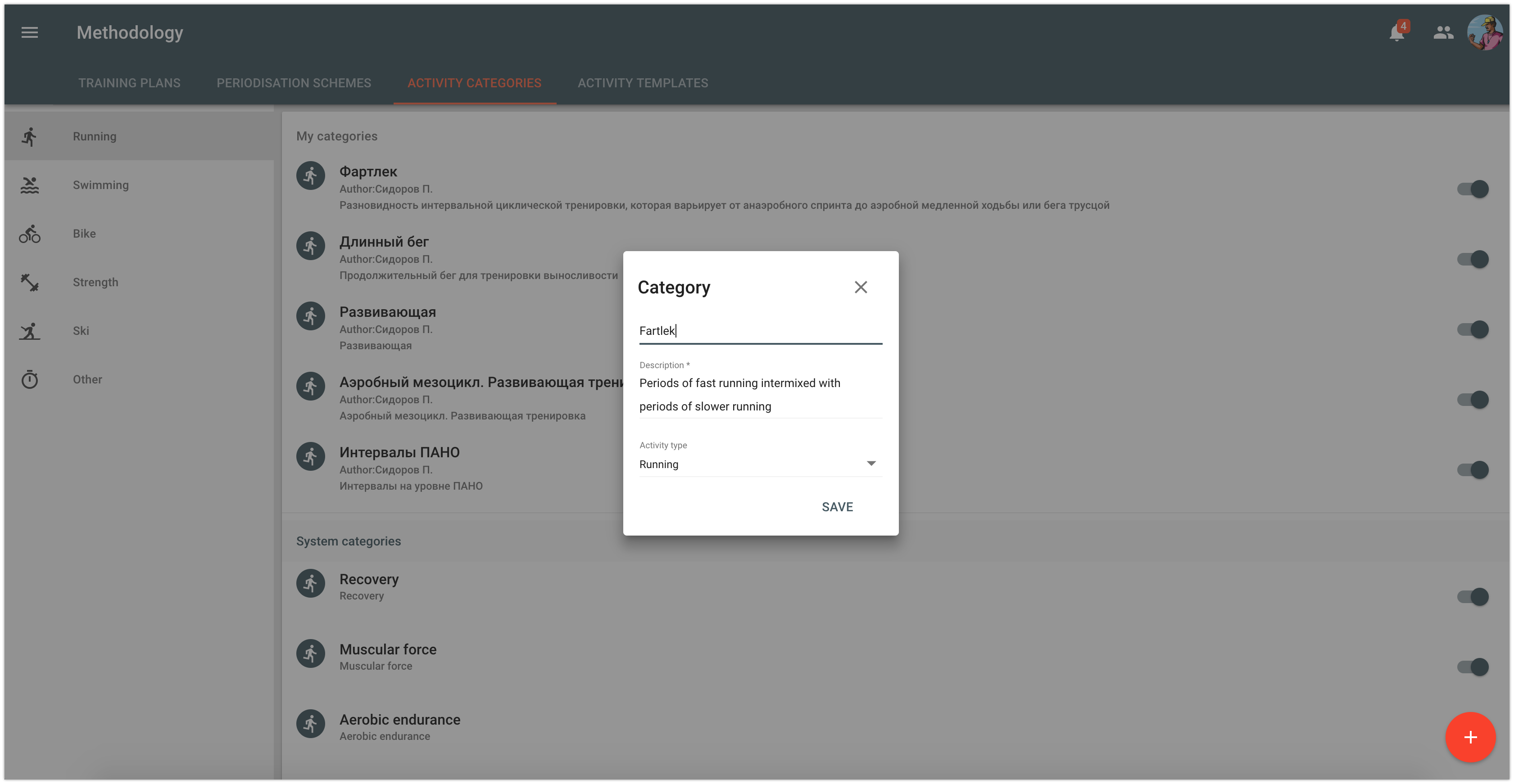Activity categories
MANAGING THE ACTIVITY CATEGORIES:
- Why do we need categories
- View categories
- Create category
- Change category
- Delete category
- Change order of categories
- Manage visibility of categories
DESCRIPTION OF THE SYSTEM CATEGORIES IN STAMINITY
- Recovery
- Aerobic endurance
- Muscular force
- Muscular endurance
- Speed skills
- Anaerobic endurance
- Sprint power
- Functional test
- Preparation for the race
- Race
MANAGING THE ACTIVITY CATEGORIES
Why do we need categories
Categories help to classify activities by types, select and compare activities of the same type, analyze dynamics of their completion and build reports.
Category - an obligatory attribute of the activity. When creating an activity, users subscribed to the basic tariff can select a category from the list of system categories, and those who have the "Premium" or "Coach" tariffs enabled, can manage their own list of categories.
View categories
In order to manage the activity categories, you should proceed to the "Methodology" section in the menu to the left and select the "Activity categories" tab:

The list of categories is provided for basic sports:
- Running;
- Swimming;
- Bike;
- Ski;
- Strength;
- Other.
Categories that are set for the basic sports are used to classify activities of derived sports.
The following information is available in the categories overview and management window:
- 1 - Tabs to switch between different sections of the "Methodology" view: Training plans - Periodization schemes - Activity categories - Activity templates;
- 2 - The list of basic sports. When you select a basic sport, the relevant categories will be displayed;
- 3-4 - Grouping categories by types. The following types are available:
- My categories - user's categories;
- Coach categories - categories which have been used by your coach in your activities;
- Club categories - categories which have been created by the club management to be used by the coaches when planning activities for the athletes;
- System categories - activity categories, used by default for all users. Further, in the article, you will find a detailed description of these categories.
- 5 - Here you can set category visibility;
- 6 - A button to add a new category.
Create category
In order to create your own category, click on the "Add new" button and fill in the category name and description. After that, the category will be added to the category list for the selected sport.

In case if you want to create a category for several sports, select them in this window when creating a new category.
Change category
You can change the categories created by you. You cannot change coach categories, club categories, and system categories.
To change a category you need to click on it and make changes in the appeared window.
Delete category
You can delete categories created by you until they are used in activities.
You cannot delete coach categories, club categories, and system categories, but you can hide them.
To delete a category you need to open its edit window and click on the "Delete" button.
Change order of categories
Categories can be sorted in a convenient order. To change the categories order you just need to drag and drop the required category.

Manage visibility of categories
For each category, you can set the attribute of its visibility. Categories marked as "invisible" won't be displayed when creating activities.
For example, you can hide one or several system categories you don't use.
DESCRIPTION OF THE SYSTEM CATEGORIES
The following system categories are used in Staminity.
- Recovery
- Aerobic endurance
- Muscular force
- Muscular endurance
- Speed skills
- Anaerobic endurance
- Sprint power
- Functional test
- Preparation for the race
- Race
This list has been created based on the activities classification offered by Joe Friel in The Triathlete's Training Bible for the development of basic and "special" skills.
Development of basic skills:
- Endurance – an ability to resist the influence of fatigue and reduce the associated negative effects.
- Muscular force — an ability to overcome the resistance.
- Speed – an ability to move effectively when swimming, cycling or running. It's a combination of technique and performance, defining how effectively do legs and arms work when moving fast.
Development of "special skills" which represent a combination of basic skills:
- Muscular endurance = muscular force + endurance
- Anaerobic endurance = endurance + speed
- Power = muscular force + speed
Recovery
Activities, performed in the first training zone after intensive activities and after competitions. The goal of such activities is to recover after the training load.
Aerobic endurance
Includes exercises, focused on aerobic maintenance and strengthening of endurance.
Endurance activities develop cardiovascular system, slowly contracting muscle fibers and improve an ability of the body to conserve glycogen and glucose, simultaneously training muscles to use fats as fuel.
Depending on the goals, such activities are completed in 1-2 and 3 training zones.
Muscular force
Activities focused on the muscular force development include activities with a high level of intensity:
- in running and cycling: moving in the hilly terrain, long ascents, repeats in the hills,
- in swimming: swimming upstream, workout using swimming paddles, resistance swimming.
Speed skills
Activities focused on the speed skills development are completed on the efforts level close to maximum. They include short and fast accelerations with pace at the level of 6-7 training zones (according to Friel).
Muscular endurance
Muscular endurance activities are focused on the simultaneous development of muscular force and speed.
Examples of activities:
- continuous movement in the third zone,
- short and long cruise intervals with intensity close to the LT,
- movement with intensity at the LT level lasting from 15-20 to 40 minutes.
Anaerobic endurance
Anaerobic endurance activities are focused on the simultaneous development of endurance and speed.
Examples of activities: various interval workouts, interval workouts in the hilly terrain, repeats, fartlek. Such activities are united by the fact that during workout intervals, the intensity level can reach zone 6 (zone 5.b)
Sprint power
Sprint power activities - activities focused on the simultaneous development of muscular force and speed.
Examples of activities: sprint accelerations with efforts level close to maximum.
Functional test
Functional test – activities during which the LT and/or the VO2 max are measured. There are many ways to conduct tests: laboratory tests on a cycle ergometer or a treadmill with gas analysis, step tests performed according to various protocols in the pool, on an exercise bicycle, at a stadium or a highway.
The result of a functional test - confirmed levels of the intensity thresholds.
Preparation for the race
Preparation includes special activities, completed the day before the race or a warm up immediately before the race.
Race
A special activity category designed for races.